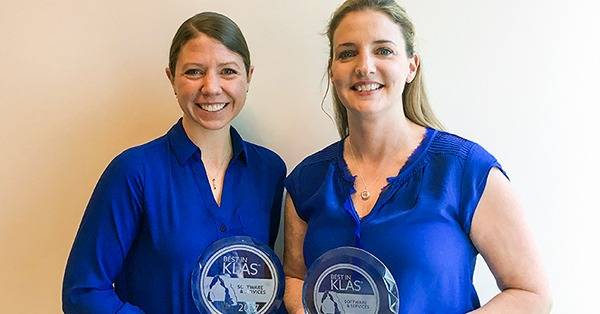- Solutions
- Solutions
- Home Health
- Hospice
- Life Plan Community
- Palliative Care
- Private Duty
- Senior Living
- Skilled Nursing
- Skilled Nursing
- Skilled Nursing Software
- Advanced Insights
- Customer relationship management
- Data and analytics
- Financial & operations management
- Marketing
- Nutrition management
- Referral management
- Regulatory compliance
- Retail management
- Resident engagement
- Revenue cycle management
- Skilled nursing interoperability
- Partners
- Blogs
- Resources
- About
- User Conference

Attracting and retaining the right senior living talent
Attracting and retaining the right senior living talent has long been a challenge for providers. And today, new factors that evolved during the COVID-19 pandemic have led to an even more competitive hiring landscape.
Senior living employers that adapt to this new workforce environment and pay attention to several key areas can position themselves for success even in light of these new challenges.
New challenges
There are long-term benefits to effective recruitment and retention of workers. An experienced, tenured staff is well attuned to the daily lives and health needs of senior housing residents, and can quickly identify changes in condition. This allows for rapid responses to illness or worsening health outcomes, and helps stave off costly liability lawsuits.
Moreover, the ability to retain staff improves operating margins by reducing the need for temporary labor and onboarding new workers more frequently. Workers who develop career paths in senior living are also the best recruiters and can help providers identify new employees.
We all know that attracting and retaining the right talent is essential for quality operations in senior housing and care. But competition for frontline workers has been fierce in recent years, during a booming economy. Pressures stemming from COVID-19 have only exacerbated the issue.
Turnover among certified nursing assistants (CNAs) rose from 36% in 2019 to 48% in 2020, while the turnover rate for all employees in assisted living facilities increased from 44% in 2019 to 53% last year.
One of the main drivers behind the increase in turnover last year was pandemic-related burnout. An April 2021 survey conducted by the Kaiser Family Foundation and the Washington Post revealed that 62% of workers in assisted living and nursing home settings experienced stress related to COVID-19 that had a negative impact on their mental health.
As we head into a post-pandemic environment, another issue that may impact employee retention is a growing confidence among workers to explore new opportunities. The uncertainty during COVID-19’s early months led many workers to hold onto their current jobs, out of a sense of security. As the economy gains momentum, half of U.S. adults who are unemployed or laid off are considering changing occupations or careers, according to a February study from Pew Research Center.
Moreover, 27% of people who changed jobs in 2020 did so to find more purposeful work, according to a report from IBM Institute for Business Value.
By focusing on a few key areas, senior living providers can appeal to those they are hiring, and also those they want to retain.
1. Focus on the mission.
The purpose-driven mission of long-term care appeals to people seeking out new professional challenges. People want to feel a deep connection to why a company exists and how it aligns with their own value system. The care provided by senior housing and skilled nursing providers makes it easy for new workers to identify that connection, and why the work is important.
2. Ask about aspirations.
Long-term care managers need to understand the evolving motivations and aspirations of employees. The pandemic gave people an opportunity to redefine what they view as important, both at work and home.
Proactive leaders should take the responsibility of having conversations with their employees to understand what is important, tailor their leadership style to meet their team’s needs, and provide benefits that are important to people.
3. Seek feedback from employees.
Managers must also be proactive in soliciting feedback from their employees, and acting on that feedback. Being open to opinions and perspectives from throughout the organization, and taking the time to listen to what those are, can make people feel appreciated and valued.
This back and forth is key to showing that employers care about their employees.
4. Reexamine employee benefits.
Long-term care providers should tailor their worker benefits to promote flexibility and wellbeing. During the pandemic, enhanced benefits including hero pay, flexible scheduling, and extended vacation time helped ease the rise of employee burnout, while working from home became commonplace for those who could do so.
Moving forward, flexibility will be one of the key benefits employees demand. The past 15 months have shown workers that working remotely has been beneficial. They can repurpose time spent commuting into sleeping more, spending time with family, working out, and saving money that would have been spent on commuting, car maintenance, and lunches, pre-pandemic.
5. Revisit compensation and incentives.
Providers must also be ready to pay higher wages to recruit and retain talent. Just as there is a hot seller’s market for home buying, it is a worker’s market for wages. Those seeking new jobs will consider jobs and careers where starting wages are higher and there is room to develop careers.
To navigate this workforce environment, providers should reevaluate their compensation practices to ensure they have things in place that matter: a strong base pay, bonuses, and long-term incentives, in addition to good health benefits.
To get details about how MatrixCare helps with attracting and retaining the right senior living talent
See what MatrixCare can do for you
MatrixCare
MatrixCare provides an extensive range of software solutions and services purpose-built for out-of-hospital care settings. As the multiyear winner of the Best in KLAS award for Long-Term Care Software and Home Health and Hospice EMR, MatrixCare is trusted by thousands of facility-based and home-based care organizations to improve provider efficiencies and promote a better quality of life for the people they serve. As an industry leader in interoperability, MatrixCare helps providers connect and collaborate across the care continuum to optimize outcomes and successfully manage risk in out-of-hospital care delivery.
MatrixCare is a wholly-owned subsidiary of ResMed (NYSE: RMD, ASX: RMD). To learn more, visit matrixcare.com and follow @MatrixCare on X
Related Posts


See MatrixCare in action
Start by having a call with one of our experts to see our platform in action.
MatrixCare offers industry-leading software solutions. Thousands of facility-based and home-based care organizations trust us to help them improve efficiency and provide exceptional care.
© 2025 MatrixCare is a registered trademark of MatrixCare. All rights reserved.






